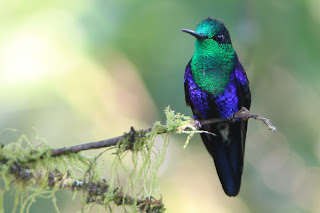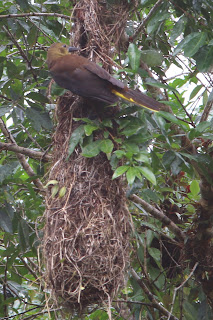In Mindo we stayed at a lodge called The Yellow House, which is renowned for its adjoining bird trails. From the balcony of our house I could spot a couple of dozen bird species. When it was not wet enough for the camera to come out, there was excellent lighting to shoot birds and the below shots are the result.
The place had a vast variety of tanagers.
514.
Blue-winged Mountain Tanager (
Anisognathus somptuosus)
515. Palm Tanager (Thraupus palmarum)
516. Lemon-rumped Tanager (Ramphocelus icteronotus)
Here's the more modestly-plumaged female of the species
...and here's the male that answers the question "Why that name?".
517. Bay-headed Tanager (Tangara gylora)
Only managed a record shot of this brilliantly coloured bird, which was feasting on a worm when I photographed it.
518. Bananaquit (Coereba flaveola)
The curiously named Bananaquit is placed in the Tanager family, but I think that placement is disputed. Until they resolve the classification, here it stays in the thraupidae family.
519. Golden Tanager ( Tangara arthus)
520. Blue-grey Tanager (Thraupis episcopus)
521.
Golden-naped Tanager (
Tangara ruficervix)
522.
White-lined Tanager (
Tachyphonus rufus)
This one's the female
The rest of these birds were higher up in the hills and deeper in the woods.
523.
Common Squirrel Cuckoo (
Piaya cayana)
524.
Choco Toucan (
Ramphastos brevis)
525.
Scaly-throated Foliage-Gleaner (
Anabacerthia variegaticeps)
526. Social Flycatcher (Myiozetetes similis)
527.
Red-headed Barbet (
Eubucco bourcierii)
Male
Female
528. Grey-capped Flycatcher (Myiozetetes granadensis)
529. Rufous Motmot (Baryphthengus martii)
The iconic Rufous motmot showed up a couple of times when I went for a walk on the trail. Both times I was unprepared with my camera to get a good shot. This is the best I could do.
530. Zeledon's Antbird (Hafferia zeledoni)
531. Olivaceous Piculet (Picumnus olivaceus)
We were just finishing up breakfast on the balcony and this tiny little woodpecker landed right in front of us, and gave me just enough of an opportunity to click this snap.
532. Black Phoebe (Sayornis nigricans)
This mother and fledgling pair sat on a wire for a good amount of time. The mother would make her sallies in the air and return with a bug each time, and the young one, kept gobbling them up.
533. Crimson-rumped Toucanet (Aulacorhynchus haematopygus)
534. Guayaquil Woodpecker (Campephilus gayaquilensis)
535. Thick-billed Euphonia (Euphonia laniirostris)
536.
Orange-billed Sparrow (
Arremon aurantiirostris)
537.
Blue-and-white Swallow (
Notiochelidon cyanoleuca)
538.
Orange-billed Euphonia (
Arremon aurantiirostris)
































































